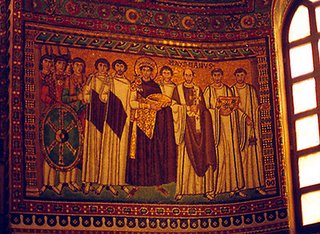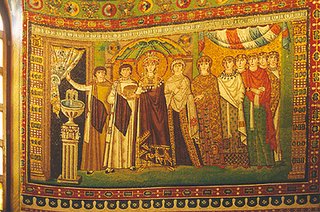Two nights and two days in fog choked Ravenna followed. Our ambitious plan was made easier by the fact that the mausoleum of Theodoric and the chapel of Aint Andrew were both closed for restoration work. That left only six (if I am not mistaken) UNESCO protected feats of the mosaicists art for us to go and gawp at. Fortunately, cameras are allowed here, although the fog cut the available light to a minimum and I had to use all my tricks to be able to shoot decent shots (not that I managed with 100% success, mind you).

Corinna wrapped against the cold as effectively as Lazarus wrapped against death on this early Christian sacrophagus
After finding our way into town in the morning, and finding a place to park - something not as easy as it sounds - we headed off to the Saint Vitale and mausoleum of Galla Placida complex where we spent quite a while walking around and marvelling at the mosaics.


I suppose I could go off on the Justinian / Theodora tangent right now and that would lead us through the Belissarius / Procopius / Narses tangents and back to the goths and all that jazz, but I'd probably forget to write about how it is that I first came to want to come to Ravenna and whether or not you can tell that Saint Vitale is an architectural copy of Saints Sergius and Bacchus in Constantinople.
One thing I was not prepared for was the material used for the windows - a sort of yellow rock cut thin enough to be translucent and used for window material in San Vitale, the mausoleum and others of the old churches we visited.

We walked across the garden to the tomb of Galla Placida where the mosaic work was far more classically roman-looking than what we are used to miscalling Byzantine. Despite the figurative art having one foot firmly in the Greco-roman tradition, the geometric designs were incredibly forward looking and modern to our eyes.

Geometric patterns on the vault of the mausoleum of Galla Palcida.
Leaving the mausoleum / Vitale area we drove to the cathedral and museum. The chapel of Saint Andrew was closed, but we managed to see the exhibits in the museum, which included some good early mosaic work and of course the amazing ivory throne of Maximian, bishop of Ravenna. I remember friends ("Hi, James!") doing late Roman art courses getting all excited about this throne of some bishop in a place I hadn't heard of, called Ravenna. This was a long time before my "Byzantine" or late roman awakening. The throne was a masterpiece of ivory work of the period and it is good to look at. We have nothing in the eastern empire of this sort (meaning the flammable sort).
We walked around the city centre of Ravenna, which is beautiful enough and hides a number of later churches which no doubt are just as exciting to those who call the 17th or 18th centuries their own.
The baptisteries and St. Apollonaris are next and they require some introduction into the whole Arian / Orthodox thing and probably also the whole Goth business. This is a different chapter.

No comments:
Post a Comment